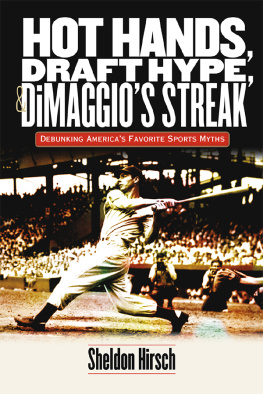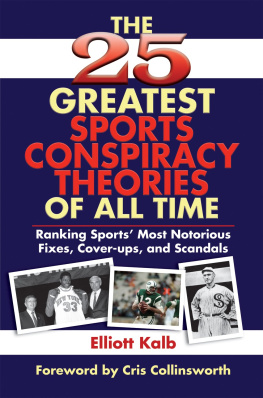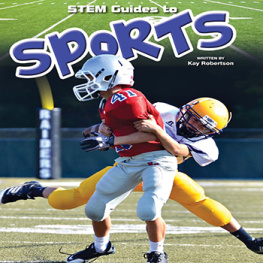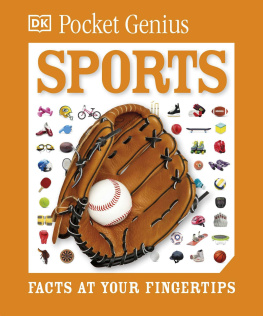
ACKNOWLEDGMENTS
Im grateful to the many people who helped with this book.
My wife, Linda, scheduled our wedding date around the 1985 NBA Finals and abided my sports addiction ever since. Cant ask for more than that. Looking forward to at least thirty-one more years together.
Our children, Robert, Jackie, and Richard, are beautiful people. Robert served as my primary reader and put every word and idea under illuminating scrutiny. Awesome job, Rob.
My mom, Shula, watched almost every match I wrestled, and supported everything Ive ever done. Thanks, Mom.
My brother, Alan, edited and provided (since our childhood) sound, creative arguments that honed or inspired much of what Ive written. This book doesnt happen without him.
My sister, Marilyn, turned out to be the best athlete in the family, and a good writer too.
Arnie Berns and Bob Cohen greatly improved various parts of the manuscript. John Middletons support also helped a lot. Thanks to them and to other great friends.
Professor Matthew Schulkind provided important scholarly advice in several areas. Thanks for educating my daughter, and me as well.
Sam Chi, editor of RealClearSports.com, provided unwavering support, good cheer, and fine advice. All sports fans should check out RealClearSports every day.
My agent, Chip MacGregor, saw potential in an early version of the book, encouraged it, and found it a fine home. Id recommend Chip to any writer.
Stephen Hull and colleagues at ForeEdge added the finishing touches, beautifully done.
SELECTED BIBLIOGRAPHY
Barra, Allen. Clearing the Bases: The Greatest Baseball Debates of the Last Century. New York: Thomas Dunne Books, 2002.
. Mickey and Willie: Mantle and Mays, the Parallel Lives of Baseballs Golden Age. New York: Crown Archetype, 2013.
Baumer, Benjamin, and Andrew Zimbalist. The Sabermetric Revolution: Assessing the Growth of Analytics in Baseball. Philadelphia: University of Pennsylvania Press, 2014.
Bowden, Mark. The Best Game Ever. New York: Atlantic Monthly Press, 2008.
Carroll, Will. Saving the Pitcher: A Revolutionary Analysis of Pitching Injuries and How to Prevent Them. Chicago: Ivan R. Dee, 2004.
Cherry, Robert. Wilt: Larger Than Life. Chicago: Triumph Books, 2004.
Donaghy, Tim. Personal Foul: A First-Person Account of the Scandal That Rocked the NBA. Sarasota, FL: Four Daughters LLC, 2010.
Faulkner, David. The Last Hero: The Life of Mickey Mantle. New York: Simon & Schuster, 1995.
Gibson, Bob, and Reggie Jackson, with Lonnie Wheeler. Sixty Feet, Six Inches. New York: Anchor Books, 2011.
Goldman, Steve, ed. Extra Innings. New York: Basic Books, 2012.
Gould, Stephen Jay. Full House: The Spread of Excellence From Plato to Darwin. New York: Three Rivers Press, 1996.
. Triumph and Tragedy in Mudville. New York: Workman, 2005.
Gray, Scott. The Mind of Bill James: How a Complete Outsider Changed Baseball. New York: Doubleday, 2006.
Hirsch, Sheldon, and Alan Hirsch. The Beauty of Short Hops: How Chance and Circumstance Confound the Moneyball Approach to Baseball. Jefferson, NC: McFarland & Company, 2011.
Jackson, Phil. The Last Season: A Team in Search of Its Soul. New York: Penguin Press, 2004.
James, Bill. The New Bill James Historical Baseball Abstract. New York: The Free Press, 2001.
. The Bill James Gold Mine 2009. Chicago: ACTA Sports, 2009.
. Solid Fools Gold: Detours on the Way to Conventional Wisdom. Chicago: ACTA Sports, 2011.
. Fools Rush Inn: More Detours on the Way to Conventional Wisdom. Chicago: ACTA Sports, 2014.
Kahneman, Daniel. Thinking, Fast and Slow. New York: Farrar, Straus and Giroux, 2011.
Kaplan, Jim. The Greatest Game Ever Pitched. Chicago: Triumph Books, 2011.
Keri, Jonah, ed. Baseball Between the Numbers. New York: Basic Books, 2006.
. The Extra 2%: How Wall Street Strategies Took a Major League Baseball Team from Worst to First. New York: Ballantine Books, 2011.
Kram, Mark. Ghosts of Manila: The Fateful Blood Feud Between Muhammad Ali and Joe Frazier. New York: Harper Collins, 2011.
Leavy, Jane. The Last Boy: Mickey Mantle and the End of Americas Childhood. New York: HarperCollins, 2010.
Lewis, Michael. Moneyball: The Art of Winning an Unfair Game. New York: W. W. Norton, 2003.
McCallum, Jack. :07 Seconds or Less: My Season on the Bench with the Runnin and Gunnin Phoenix Suns. New York: Touchstone, 2006.
Moskovitz, Tobias J., and L. Jon Wertheim. Scorecasting: The Hidden Influences Behind How Sports Are Played and Games Are Won. New York: Crown Archetype, 2011.
Paulos, John Allen. Inumeracy. New York: Holt McDougal, 2001.
. A Mathematician Reads the Newspaper. New York: Anchor Books, 1995.
Pierce, Gregory F. Augustine, ed. How Bill James Changed Our View of Baseball. Chicago: ACTA Sports, 2007.
Reisler, Jim. The Best Game Ever: Pirates vs. Yankees, October 13, 1960. New York: Carroll & Graf Publishers, 2007.
Remick, David. King of the World. New York: Random House, 1998.
Ross, John P. The 1964 Phillies: The Story of Baseballs Most Memorable Collapse. Jefferson, NC: McFarland & Company, 2005
Ruth, Babe, as told to Bob Considine. The Babe Ruth Story. New York: Scholastic Book Services, 1948.
Sherman, Ed. Babe Ruths Called Shot. Guilford, CT: Lyons Press, 2014.
Tango, Tom M., Mitchel G. Lichtman, and Andrew E. Dolphin. The Book: Playing the Percentages in Baseball. Washington, DC: Potomac Books, 2007.
Tetlock, Philip E., and Dan Gardner. Superforecasting: The Art and Science of Prediction. New York: Crown Publishers, 2015.
Thorn, John, and Pete Palmer. The Hidden Game of Baseball: A Revolutionary Approach to Baseball and Its Statistics. New York: Doubleday, 2005.
WEBSITE RESOURCES
The following websites provided most of the statistics cited in this book:
www.baseball-reference.com
www.basketball-reference.com
www.fangraphs.com
www.pro-football-reference.com
DiMaggios Hitting Streak Is Overrated
Joe DiMaggios 56-game hitting streak is widely considered in the realm of epic sports feats that includes Wilt Chamberlains 100-point game, Bob Beamons 29-feet-2-inch broad jump, Wayne Gretzkys 92-goal season, and the like. Some sports fans even regard it as the greatest achievement in sports history.
As sacrilegious as this may seem, The Streak does not deserve that sort of veneration. DiMaggio certainly had a terrific 56-game run in 1941 with a .408 batting average and fifteen home runs. However, several players out-hit DiMaggio over 56-game sequences: Rogers Hornsby batted .476 over 56 games in 1924; George Brett hit .480 over 56 games in 1980; and, notably, over the exact time period of DiMaggios streak, Ted Williams (in 55 games) hit .412 with more than twice as many walks and a higher on-base plus slugging percentage.
History celebrates DiMaggios 56 games over the superior feats of Hornsby, Brett, and Williams solely by virtue of the consecutive-game hitting. However, The Streak is based on a contrived form of consecutivenessat least one hit in every gamein which the hits are unrelated, separated from each other by many at bats; that is to say, they have zero interactive value. This oxymoronic interrupted consecutiveness provides none of the benefit of true consecutiveness, as demonstrated by, for example, successive hits in an inning leading to runs, or planks laid in a row constructing a bridge.











